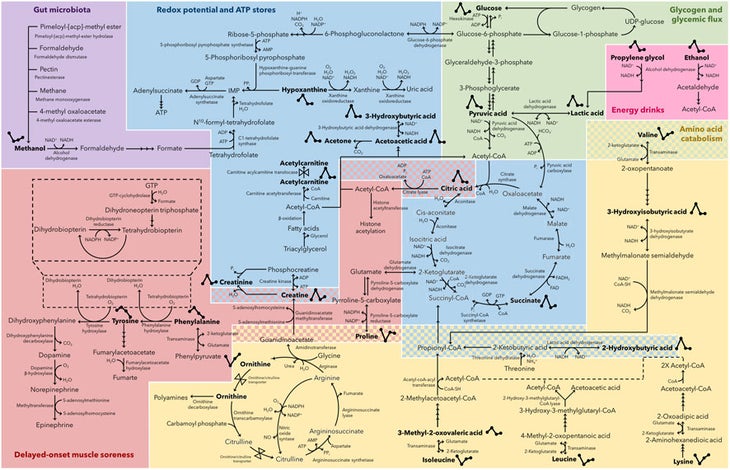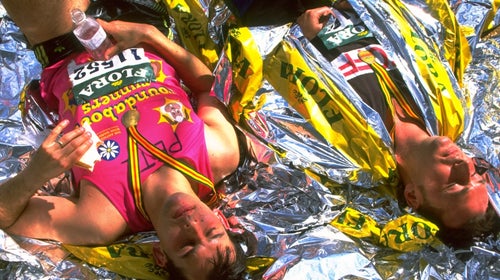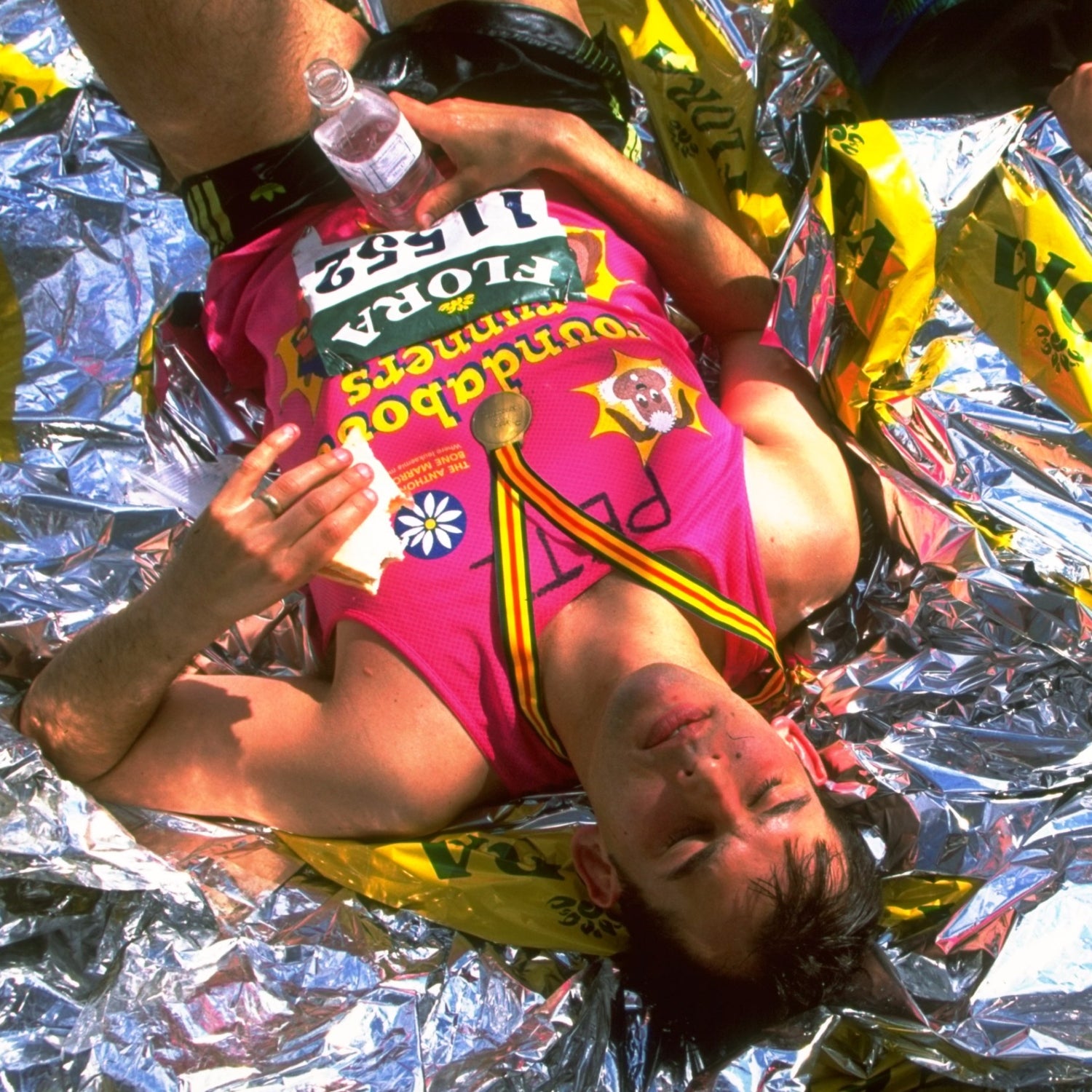One of the big challenges for recovery research is figuring out what it means to be recovered. Maybe it’s the point at which, after a marathon, you’re able to start walking down the stairs forward instead of backward. Or if you want to be more scientific about it, maybe it’s the point when all the various markers of physiological stress in your bloodstream—low fuel stores, damaged muscles, inflammation, and so on—have returned to normal.
But which markers matter? Scientists have made all sorts of educated guesses over the years. For example, showed that creatine kinase, a marker of muscle damage, jumped on average by 2,000 percent after the race, but was back to normal four weeks later. (The race winner, Bill Rodgers, had still had fairly high levels four weeks later, but that was probably just a result of his normal training.) Subsequent studies have looked at other markers like and stress, but the real-world significance of these measures remains hotly debated.
takes the physiological markers approach and cranks it up to eleven. A team led by Rachelle Bester and Du Toit Loots at North-West University in South Africa applies an approach called “metabolomics” to explore the recovery of marathon runners. With this method, instead of identifying specific markers to track before and after the marathon, they take a series of blood tests and measure everything—or at least every molecule below a certain size threshold—that shows up. By comparing the results from before the race, immediately after, and then 24 and 48 hours post-race, they can figure out which metabolites are altered by running a marathon and how quickly they return to normal.
The word “metabolome” was coined back in the 1990s as a mash-up of “metabolite” and “genome.” Just as the genome is the complete set of genes in an organism and the proteome is the complete set of proteins, the metabolome is the complete set of metabolites. I first encountered the term in 2007 when I was working on a magazine profile of a scientist at the University of Alberta named David Wishart, who had just led the publication of the first draft of the , an attempt to catalogue all the metabolites that show up in human biofluids. At the time, the database had just over 2,000 entries; the latest version has more than 200,000. In practice, there’s no such thing as a “complete” metabolome, because in addition to the molecules produced by chemical reactions in your body there is also an effectively infinite list of other molecules that can come from food, drugs, and the environment.
The big draw of metabolomics is that it responds rapidly to stimuli. Running a marathon won’t change your genes, but it will definitely change your metabolome—and those changes will tell you about the processes going on inside your body in response to the stress. For this study, the researchers recruited 15 participants in the Druridge Bay Marathon, a fairly brutal-sounding race that includes paved surfaces, grass, and four miles of soft sand. The runners had an average age of 40 and an average finish time of 4:25.
The researchers used a technique called nuclear magnetic resonance to identify as many metabolites as possible, then checked to see which ones changed over the two days following the race. Overall, they found 26 metabolites that fluctuated significantly over the course of recovery, including four (valine, tyrosine, ethanol, and methanol) that still hadn’t returned to baseline levels after 48 hours. This is an intriguing prospect, the researchers point out, because it might give us some new ideas about which supplements or foods we should take more of before and after a marathon.
In practice, though, things get complicated. The metabolites they identify fall broadly into five categories:
-refilling cellular ATP and oxygen levels (e.g. hypoxanthine, ketone bodies, citric acid, carnitine)
-refilling glycogen (carbohydrate) stores in the muscles (e.g. glucose, pyruvic acid)
-making amino acids and repairing muscle damage (e.g. proline, creatine, citric acid)
-restoring gut microbiota (e.g. methanol)
-energy drinks (ethanol, propylene)
That last one may catch you by surprise, but apparently many energy drinks have ingredients such as ginseng that are dissolved in small amounts of alcohols, and your ability to clear them out of your system is reduced during prolonged exercise.
What’s the practical takeaway? In their conclusions, the researchers identify phenylalanine, tyrosine, valine, and proline as potential targets for supplementation. But it’s not as simple as “these metabolites were low, so you should take more of them.” Both phenylalanine and tyrosine are higher than normal immediately after the marathon, possibly because of reduced liver function and decreased brain glycogen levels during the race. Then, over the next two days, levels drop below baseline because of the elevation of inflammatory markers associated with muscle soreness, which in turn increases levels of dopamine and other neurotransmitters that may modulate muscle pain—which is why they speculate that supplementing phenylalanine or tyrosine might be worth trying.
If that explanation doesn’t really make sense, it’s because I’m vastly oversimplifying the breakdown given in the journal article (which is ). In fact, the highlight of the paper is the incredible diagram below, which I include more as a masterpiece of conceptual art than for its explanatory powers. This “metabolic map” shows the various metabolites and their reactions, and how they relate to each other. The 26 metabolites that change during post-marathon recovery are highlighted in bold, and the colors indicate general functions like delayed-onset muscle soreness.

Don’t stare too closely at this, or you’ll go blind. (That said, if you want to see a higher-res version, go to .)
To me, the takeaway from all this is definitely not that you should start searching for phenylalanine on Amazon. What I take from the diagram above is a new appreciation for how narrow our perspective is when we test a single metabolite in isolation. Metabolomics, David Wishart told me when I was reporting that long-ago profile, is “like looking through a picture window to see the world, instead of looking through a keyhole.” The view through that picture window is remarkable for its complexity and its Rube Goldberg-style interconnectedness. With a system like that taking care of our recovery after hard exercise, is it any wonder that our attempts to accelerate recovery have mostly produced mediocre results?
For more Sweat Science, join me on and , sign up for the , and check out my book .


